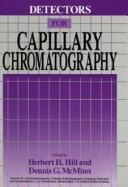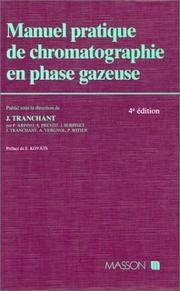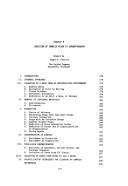| Listing 1 - 6 of 6 |
Sort by
|

ISBN: 0471506451 Year: 1992 Volume: vol 121 Publisher: New York Wiley
Abstract | Keywords | Export | Availability | Bookmark
 Loading...
Loading...Choose an application
- Reference Manager
- EndNote
- RefWorks (Direct export to RefWorks)
Chromatografie [Gas] --- Chromatographie gazeuse --- Detectoren --- Detectors --- Détecteurs --- Gas chromatography --- Senseurs --- Sensoren --- Sensors --- Chromatographic detectors. --- Gas chromatography. --- Chromatography, Gas --- methods. --- Detectors. --- Methods.
Book
ISBN: 3540125892 0387125892 3642692273 3642692257 9783540125891 Year: 1986 Publisher: Berlin Heidelberg New York Springer
Abstract | Keywords | Export | Availability | Bookmark
 Loading...
Loading...Choose an application
- Reference Manager
- EndNote
- RefWorks (Direct export to RefWorks)
543.544 --- HPLC high performance liquid chromatography --- analytische chemie (scheikunde) --- biochemie --- chromatografie --- farmacologie --- fysicochemische analyse --- vloeistofchromatografie --- Chromatografische analyse. Chromatografie --- Liquid chromatography. --- Chromatography, High Pressure Liquid. --- Chromatographie gazeuse. (Congrès) --- Vloeistofchromatografie. (Congres)

ISBN: 2225846812 Year: 1995 Publisher: Paris : Milan : Barcelone : Masson ,
Abstract | Keywords | Export | Availability | Bookmark
 Loading...
Loading...Choose an application
- Reference Manager
- EndNote
- RefWorks (Direct export to RefWorks)
Chromatografie [Gas] --- Chromatographie gazeuse --- Gas chromatography --- Chromatographie en phase gazeuse --- Matériel --- Equipment --- Échantillonnage --- Sampling --- Analyse quantitative --- Quantitative analysis --- Spectrométrie de masse --- Mass spectrometry --- Chromatographie en phase gazeuse. --- GAZ CHROMATOGRAPHY --- LABORATORY MANUALS
Dissertation
Year: 2019 Publisher: Liège Université de Liège (ULiège)
Abstract | Keywords | Export | Availability | Bookmark
 Loading...
Loading...Choose an application
- Reference Manager
- EndNote
- RefWorks (Direct export to RefWorks)
Comprehensive two-dimensional gas chromatography (GC×GC) coupled to high-resolution time-of-flight mass spectrometer (HRTOFMS) has been used to perform non-recreational cannabis strains differentiation. The sampling method, based on dynamic headspace and thermal desorption (TD), has been optimized to maximize volatile organic compound (VOC) collection. Volatile profiles of nine cannabis flowers were collected at room temperature using thermal desorption tubes. Terpenes and other specific volatile compounds emitted by the flowers have been used through advanced data analysis. Different data pre-treatments have been investigated on raw data prior to statistical analysis. Principal component analysis (PCA) has been used to visualize the impact of pre-processing. Based on the selected data treatment, five strains out of the nine were selected for strain differentiation. Furthermore, the global chemical classes repartition, odor profile, and medical effects of strains were investigated. Major compounds listed in literature have been successfully identified by the HRTOFMS, using the combination of specific fragmentation and high mass accuracy to increase the confidence in compounds identification. In conclusion, strains have been separated upon PCA results, which has shown also its potential to differentiate cannabis subspecies. Moreover, compound investigation has shown similar profile of aromas with different major flavors in different strains and has shown different medical compound amounts proving the medical potential of cannabis-based products uses. La chromatographie en phase gazeuse bidimensionnelle (GC×GC) couplée à la spectrométrie de masse à temps de vol à haute résolution (HRTOFMS) a été utilisée pour différencier des fleurs de cannabis à usage non-récréatif. La méthode d’échantillonnage, basée sur l’échantillonnage dynamique de l’espace de tête et sur la désorption thermique (TD), a été optimisée afin de maximiser la collection de composés organiques volatils (COVs). Les COVs de neuf fleurs de cannabis ont été récoltés à température ambiante à l’aide de tubes de désorption thermique. L’analyse des données s’est basée sur le profil des terpènes et autres composés volatils des fleurs. Des pré-traitements des données ont été effectués avant leurs analyses statistiques. L’analyse par composante principale (ACP) a été utilisée afin de visualiser l’impact du pré-traitement sur les données. A partir des données sélectionnées après le pré-traitement, cinq fleurs sur les neufs ont été sélectionnées en vue de les différencier. La répartition globale des classes de composés chimiques, le profil des odeurs et des effets médicaux des fleurs ont également été étudiés. Les composés majeurs référencés dans la littérature ont été identifiés par la HRTOFMS qui confère une haute précision de la masse et une plus grande certitude dans l’identification des composés. En conclusion, les fleurs ont été séparées selon leurs résultats d’ACP. Celle-ci a montré son potentiel pour différencier les sous-espèces de cannabis. De plus, l’analyse des composés a montré des profils d’odeurs similaires, avec des arômes majoritaires dans les différentes fleurs. Elle a aussi montré la présence de composés médicinaux, montrant le potentiel médical des produits basés sur le cannabis.
Comprehensive two-dimensional gas chromatography --- Cannabis --- Volatile organic compounds --- Thermal desorption --- High resolution time-of-flight mass spectroscopy --- Chromatographie gazeuse bidimensionnelle --- Cannabis --- Désorption thermique --- Spectroscopie de masse à temps de vol à haute résolution --- Composés organiques volatils --- Physique, chimie, mathématiques & sciences de la terre > Chimie
Book
ISBN: 0471909807 Year: 1988 Publisher: New York Wiley
Abstract | Keywords | Export | Availability | Bookmark
 Loading...
Loading...Choose an application
- Reference Manager
- EndNote
- RefWorks (Direct export to RefWorks)
Fysicochemical separation methods --- Chromatografie [Gas] --- Chromatographie en phase liquide à hautes performances --- Chromatographie gazeuse --- Chromatographie liquide --- Gas chromatography --- High performance liquid chromatography --- Liquid chromatography --- Vloeistofchromatografie --- Chromatographie en phase gazeuse --- Gaschromatografie --- 543.544 --- 543.2 --- Chromatographie en phase liquide à hautes performances --- High performance chromatography --- High pressure liquid chromatography --- High sensitivity liquid chromatography --- High speed liquid chromatography --- HPLC (Chromatography) --- High pressure (Science) --- Gas-liquid chromatography --- GLC (Chromatographic analysis) --- Vapor-phase chromatography --- Chromatographic analysis

ISBN: 0824766415 Year: 1978 Volume: 9 Publisher: New York Basel Dekker
Abstract | Keywords | Export | Availability | Bookmark
 Loading...
Loading...Choose an application
- Reference Manager
- EndNote
- RefWorks (Direct export to RefWorks)
Analysis of pharmaceuticals --- Drugs --- Gas chromatography --- High performance liquid chromatography --- Médicaments --- Chromatographie en phase gazeuse --- Chromatographie en phase liquide à hautes performances --- Analysis --- Analyse --- Chromatography, Gas --- Chromatography, High Pressure Liquid --- Pharmaceutical Preparations --- -Gas chromatography --- High performance chromatography --- High pressure liquid chromatography --- High sensitivity liquid chromatography --- High speed liquid chromatography --- HPLC (Chromatography) --- High pressure (Science) --- Liquid chromatography --- Gas-liquid chromatography --- GLC (Chromatographic analysis) --- Vapor-phase chromatography --- Chromatographic analysis --- Medicaments --- Medications --- Medicine (Drugs) --- Medicines (Drugs) --- Pharmaceuticals --- Prescription drugs --- Bioactive compounds --- Medical supplies --- Pharmacopoeias --- Chemotherapy --- Materia medica --- Pharmacology --- Pharmacy --- instrumentation --- analysis --- Gas chromatography. --- High performance liquid chromatography. --- Analysis. --- Médicaments --- Chromatographie en phase liquide à hautes performances --- Gaschromatografie. --- Vloeistofchromatografie. --- Médicaments. Analyse. --- Chromatographie gazeuse. --- Chromatographie liquide. --- Geneesmiddelen. Analyse.
| Listing 1 - 6 of 6 |
Sort by
|

 Search
Search Feedback
Feedback About
About Help
Help News
News